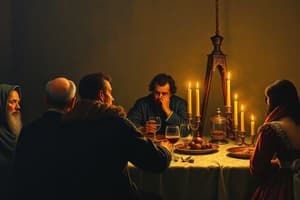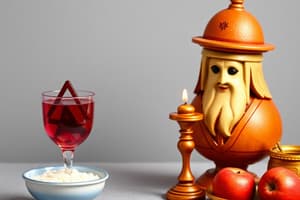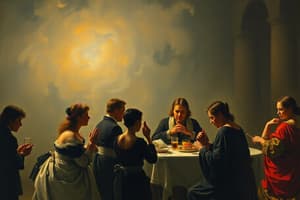Podcast
Questions and Answers
What is Hatarat Nedarim?
What is Hatarat Nedarim?
- A ritual for confessing sins
- The canceling of all promises and vows (correct)
- The act of making promises
- A celebration of the New Year
Rosh HaShana is chosen as the day of judgement because Adam Ha'Rishon sinned on this day.
Rosh HaShana is chosen as the day of judgement because Adam Ha'Rishon sinned on this day.
True (A)
What is the significance of the term 'Simana Milta'?
What is the significance of the term 'Simana Milta'?
Symbols are real
The final meal on Erev Yom Kippur is called __________.
The final meal on Erev Yom Kippur is called __________.
Match the following terms with their meanings:
Match the following terms with their meanings:
What happens to a Beinoni's judgement on Rosh Hashana?
What happens to a Beinoni's judgement on Rosh Hashana?
One is allowed to wash on Yom Kippur.
One is allowed to wash on Yom Kippur.
Why do we eat apples and challah in honey on Rosh Hashana?
Why do we eat apples and challah in honey on Rosh Hashana?
Hashem only forgives sins between us and people if those people __________.
Hashem only forgives sins between us and people if those people __________.
What does the word 'Neila' mean?
What does the word 'Neila' mean?
Flashcards are hidden until you start studying
Study Notes
Rosh Hashana
- Hatarat Nedarim is the canceling of all promises and vows.
- Hatarat Nedarim is performed before Rosh Hashana to ensure that people are not judged for breaking promises.
- Selichot is a special prayer recited before Rosh Hashana, often at dawn.
- Rosh Hashana is considered the day of judgment because Adam Ha'Rishon was judged on this day after sinning.
- There are three books used on Rosh Hashana for judgment: Tzadikim (good people), Reshaim (evil people), and Beinonim (those who are in-between).
- Beinonim are people who are evenly balanced between good and evil.
- The judgment of Beinonim is postponed until Aseret Yimei Teshuva and signed on Yom Kippur.
- Simana Milta means symbols are real and highlights the significance of practices like eating apples dipped in honey for a sweet year.
- The Mashel of the grandmother who forgets her grandchild's birthday illustrates the importance of remembering the good deeds we have done throughout the year, symbolized by honey.
Yom Kippur
- Kapparot is the custom where people take a chicken or money over their heads on Erev Yom Kippur for atonement.
- The mitzvah on Erev Yom Kippur is to eat.
- It's important to ask forgiveness from people on Erev Yom Kippur because Hashem will only forgive the sins between people if those people have forgiven us.
- During Vidur, people pound their chests to express repentance and ask for forgiveness.
- The final meal on Erev Yom Kippur is called Seudat HaMafseket.
- Four things one cannot do on Yom Kippur: Eating, Drinking, Washing, Anointing oils, Leather Shoes.
- We wear white on Yom Kippur to symbolize purity and cleanliness.
- Kol Nidrei is a prayer said three times, each time a little louder.
- Neila is the special additional Amida prayer recited on Yom Kippur.
- The word Neila means closing, symbolizing the end of Yom Kippur.
- We read the Book of Jonah on Yom Kippur because it demonstrates Hashem's willingness to accept repentance.
Studying That Suits You
Use AI to generate personalized quizzes and flashcards to suit your learning preferences.




